Catfish Summary Fact Sheet
Production
- 4 – 6 months (Depending on the stocking size, density, management practices and market demand).
- Pond and tanks: 243
- Cage: insignificant
- 13,118 Mt (2016)
- 14,351 Mt (2017)
- 19,155 Mt (2018)
- 13,088 Mt (2019)
Source: Computed from Data from MoFAD APR, 2019
Organic:
- Poultry Dropping,
- Pig Dropping and
- Cow Dung
Inorganic:
- Single Superphosphate,
- Triple Superphosphate,
- NPK (15:15:15)
- Poultry Dropping,
- Cattle Dropping and
- Pig Droppings.
Application rate is between 500 -1,000 kg per Ha
- 25.2 %
Source: 2019 APR, MoFAD
- Public - 3
- Private - 105
- Raanan Fish Feed
- Cycle Farms
- Huawei
- Beacon Hill Fish Feed
Four (4) main local producers
- Ashanti
- Western North
- Eastern
- Western
- Central
Productivity
- Pond: 800,000
Market & Trade
- Ghana's per capita consumption of fish is 25kg, higher than the world's average.
___
General Overview of Catfish Production
Aquaculture is one of the world’s fastest food production sectors with great potential for the supply of protein, income generation, poverty alleviation, enhanced trade and economic benefits. The rapid growth has made the sector important to the economy of many developing countries, including Ghana. Aquaculture can be profitable if the operator has the right natural resources, good management abilities and sufficient capital available for investment in the enterprise. Aquaculture is currently being emphasised in Ghana as an alternative to capture fisheries due to the decline in wild stock from natural water bodies. Ghana is a high fish consuming country, with per capita consumption of about 25kg.
Of the total aquaculture production in Ghana, catfish provides an average of about 14% from 2015 to 2019. Catfish culture in Ghana is done in ponds and tanks usually as a monoculture and sometimes in polyculture with other species like the tilapias (especially the Nile tilapia – Oreochromis niloticus) and the African bony tongue (Heterotis niloticus). A few farmers have tried catfish culture in cages with varying results.
The major constraints related to catfish production include inadequate quality seed (fingerlings), high cost of feed, lack of credit facility and cannibalism.

The first half of 2022 saw a sharp increase in the cost of catfish, particularly around Easter. The increase is linked to a rise in the price of fish feed components including maize, soy, and fish oil on the international market. The price increase of catfish in Ghana during the first half of 2022 can also be attributed to an increase in import levies, a depreciation in the local currency against key foreign currencies, and a high cost of energy.
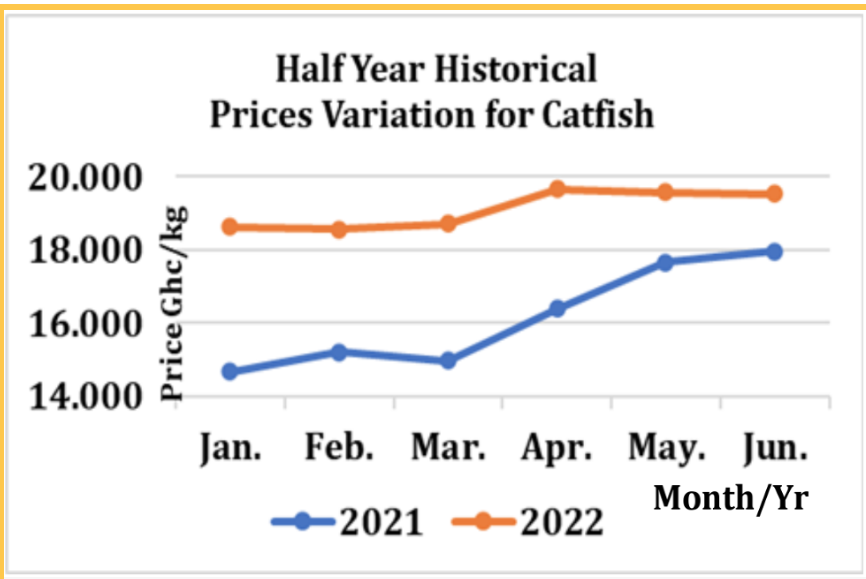
S.W.O.T analysis of Catfish
Strengths
| Weaknesses
|
Opportunities
| Threats
|
General Overview of Aquaculture Production in Ghana (2015 – 2019)
| Indicator | Year | ||||
| 2015 | 2016 | 2017 | 2018 | 2019 | |
| Production Facilities | |||||
| No. of Ponds | 3,915 | 4,132 | 4,385 | 4,523 | 4,925 |
| No. of Cages | 7,607 | 8,415 | 8,415 | 10,102 | 10,102 |
| Total | 11,517 | 12,547 | 12,800 | 14,625 | 15,027 |
| Total Surface Area of Ponds (ha2) | 805.00 | 833.40 | 846.21 | 857.73 | 934.00 |
| Total Volume of Cages (m3) | 1,699,328 | 1,080,702 | 1,080,702 | 1,201,262 | 1,201,262 |
| Fish Production, mt | |||||
| Ponds | 2,410.00 | 2,713.70 | 7,407.24 | 11,069.00 | 11,919 |
| Cages | 42,150.00 | 47,171.70 | 43,500.00 | 56,645.00 | 30,345,00 |
| Dams & Dugouts | 2.050 | 2,584.60 | 6,500 | 8,906 | 10,086 |
| Total (mt) | 46,610.00 | 52,470.00 | 57,407.24 | 76,620.00 | 52.350.00 |
| % Contribution | |||||
| Tilapia (%) | 92 | 93 | 80 | 91 | 74 |
| Catfish (%) | 8 | 7 | 20 | 9 | 26 |
| No. of Operators | |||||
| Small-scale farmers (<51mt/annum) | 2,167 | 2,160 | 1,852 | ||
| Medium scale farmers (51-100mt/annum) | 15 | 14 | 14 | ||
| Large scale farmers (>100mt/annum) | 11 | 11 | 11 | ||
| Total | 2,193 | 2,185 | 1,877 | ||
___
Catfish Value Chain
Input Dealers
The major inputs required for catfish production are ponds or tanks, good quality water, fingerlings, fish feed, drugs and chemicals, equipment and technical information. Some youths have been trained and formed Pond Construction Gangs to construct fish ponds for potential and existing farmers for a fee.
Wontesty Ventures one pond construction company specialises in the planning, design, construction and maintenance of aquaculture production and holding facilities, with a focus on Recirculating Aquaculture System (RAS) and lined ponds.
There are currently 108 functional hatcheries in Ghana - 3 public and 105 private. The public hatcheries include Pilot Aquaculture Centre (PAC) at Kona - Odumase in Ashanti Region, Ashaiman Demonstration Centre (ADC) in the Greater Accra Region and Aquaculture Research and Development Centre (ARDEC) at Akosombo in the Eastern Region. Three other public hatcheries are under construction at Vea, Dormaa Ahenkro and Sefwi-Wiawso.
Catfish feed producers, include Raanan Fish Feed, Aller aqua, Cycle Farms, Huawei and Beacon Hill Fish Feed and numerous dealers.
Other input dealers include:
- Akriset Enterprise: Sells fish farm input and products ranging from equipment for fish farm setups, fish hatchery operations, grow out production and other accessories except fish feed such as Ovaprim, Artemia, Aerators, oxygen ring blower, water quality meters/probes, harvesting nets etc.
- CCT Group Limited: Imports and distribute fishing gears.
Fish Feed Formulations by some companies
- Aller Aqua
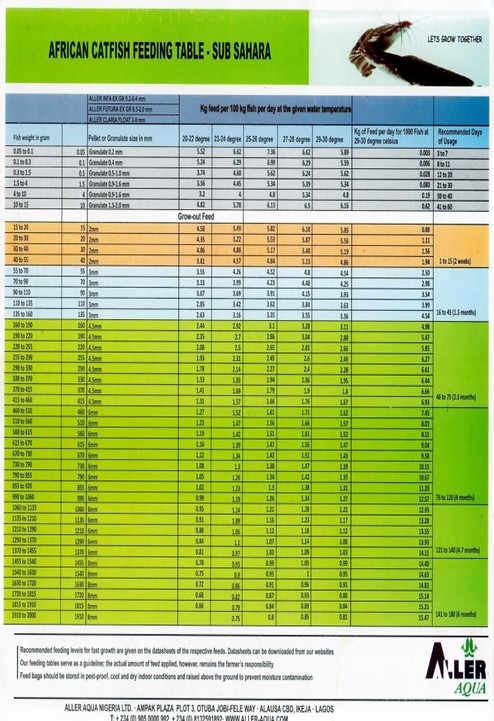
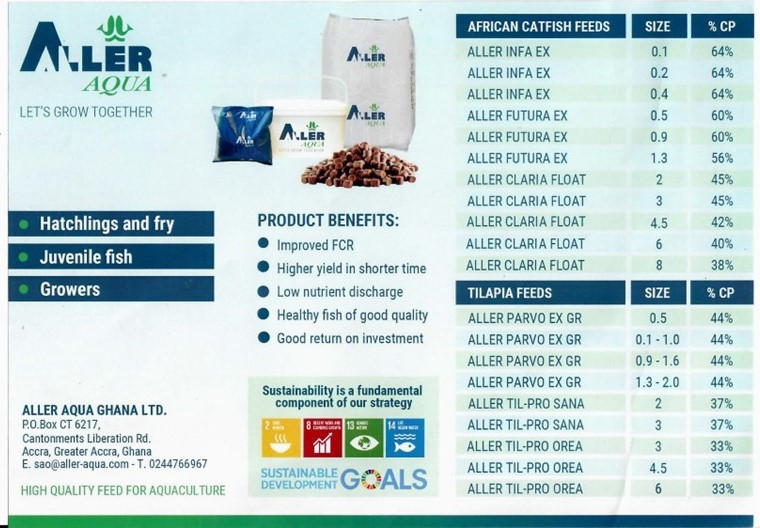
Producers
The African catfish producers include pond and tank farmers. The catfish is either cultured as a monoculture (pure stand) or as polyculture with other species like the African bony tongue (Heterotis niloticus) and the Nile tilapia. In polyculture system, catfish is typically used as a predatory species to control over - reproduction in mixed-sex tilapia culture in order to enhance the growth of the tilapia. The five top producing regions in Ghana are Ashanti, Western North, Eastern, Western and Central.
The major constraints to production include high cost of inputs (especially feed), inadequate or lack of credit facility, inadequate technical know-how (especially with small-scale farmers) and cannibalism.
Processors
Processors are crucial in post-production handling of catfish. Typically, smoking is used to add value to the fish and also serves as a means of preservation. Smoking also helps expand the market for the fish, enabling distant consumers easy access.
DAA Fisheries Training Center (DFTC) located at Kokrobite accredited by COTVET provides training in fish processing.
Traders
Cultured catfish is mainly sold fresh at the farm gates. Fish traders include wholesalers (private individuals and producers) and retailers. Typically, retailers buy directly from producers at farm gates or from wholesalers and smoke for sale by hawking or at designated points. Cultured catfish has not penetrated fish markets to a large extent as compared to the wild stock.
The prevailing marketing system for catfish is fragmented and not as fluid as that of tilapia. Usually, small-scale farmers who are ill-prepared are at the mercy of the middlemen, who pay low prices. Although such producers have the option of retailing directly to the consumer, thereby improving pricing, this puts all the risks of transaction to the farmer.
Consumers
The preference among most consumers is for smoked catfish, hence the major product form is smoked. However, catfish joints for fresh products operate in some residential areas and around night clubs in Ghana. Referred to as “point and kill” joints, customers can select live catfish of preferred size from a holding tank, which is then cooked into pepper soup or grilled and served with a meal of choice.
Even though consumers neither participate in the production nor value addition, they are part of the chain, driving the whole process. Therefore, consumer demand is a determining factor for the kind, amount and quality of a product (UNIDO, 2009).
___
Key Production Practices for Catfish
Key Production Practices and their Importance
| Good Aquaculture Practices (GAqPs) | Brief Description and Importance |
Fish Seed
| Good quality fingerlings (5 -10g) can be obtained from certified hatcheries. African catfish is appreciated for culture because of its hardiness, high growth potential and taste. It can withstand adverse environmental (especially very low oxygen) conditions for some time as it has accessory breathing organs. It can be cultured at high stocking density. Three production cycles are possible in tanks and perennial ponds and can be grown in polyculture with other fishes. |
| Fingerlings | Fingerlings may be sourced from certified hatchery operators or produced on-farm. Production on-farm is more reliable but more demanding. |
Site Selection
| Select site of soils with clay content of 30 - 35% for pond construction in order to ensure impermeable pond bottom and dikes (to minimise water losses). Top soil should be used to dress the pond dikes. Other factors to consider: a. The number and sizes of ponds to be constructed b. Availability of good quality water sources c. Amount of water needed for each pond in your farm d. Climate and rainfall patterns
Environment - do not locate your farm in a wetland or flood plain of a river. |
| Production Calendar for Catfish |  |
| Pond Preparation | Pond preparation involves complete drainage of pond, removal of weeds, complete drying of pond bottom, removal of excess silt, disinfection, filling of pond with water. Some considerations in pond preparation:
|
Production system design
|
Recirculation systems have been developed to culture fish all year-round under controlled conditions. Although the design elements of recirculation systems vary widely, the main components of RAS consist of fish rearing tanks, a solids removal device, a biofilter, an aerator or oxygen generator and a degassing unit. Some systems apply additional treatment processes such as ozonation, denitrification and foam fractionation. Rearing tanks are generally circular to facilitate solids removal, although octagonal tanks and square tanks with rounded corners provide a suitable alternative with better space utilization. |
Stocking
| a. Stock 5-50 fingerlings per square meter, depending on production system, management and market needs or demand
b. Stock fish early in the morning, if possible. c. Before releasing fish into your pond, make sure the temperature of the receiving waters is about the same as the temperature of the transport water (by allowing a gradual exchange of water between the two). d. Fish should be allowed to swim out freely from the bags/containers into their new environment e. Remove any dead fish from the pond |
| Feeding | Feed accounts for about 70% of catfish production costs. Feed should be of high quality, obtained from a certified manufacturer, formulated for catfish, properly stored and consistently available. All things being equal, feeding times affect the weight gain. Thus, feed offered twice a day will produce more weight gain than a single daily feeding of the same quantity. Hence, careful attention to feed cost against quality must be combined with good feeding practices to get value for money. Feeding catfish to satiation presupposes that the fish are regulating feed intake in response to their physiological condition, water quality, feed quality or disease situation. The use of feeding schedules should be combined with daily observations and judgment based on feeding behavior - the use of floating feed permits this observation. Fish feed can be in many forms and sizes such as powder, pellets, or crumbles depending on the age of the fish, the feeding habit and the culture. Sinking pellet feeds are good for fish that feed from the bottom, example catfish. Types of fish feed and their examples:
Feed Conversion Rate (FCR)
Importance of FCR
Thus, the FCR allows the farmer to make wise choices in selecting and using feed to maximise profitability. Some factors that affect FCR
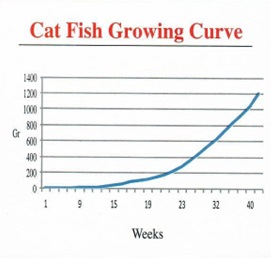 |
Water Quality
| Good quality water is the foundation of fish health and successful tilapia culture. Water quality parameters to be monitored include dissolved oxygen, temperature, ammonia, alkalinity, pH, turbidity, total hardness and nitrite. The geographic range for tilapia culture is limited by their temperature-sensitivity. The ideal water temperature for optimal growth is 25 – 30 ºC. Other water quality parameters and their acceptable ranges include:
Fish production can be greatly affected by excessively low or high pH. Extreme pH values can even kill your fish. The growth of natural food organisms may also be greatly reduced. The critical pH values vary according to the fish species, the size of individual fish and other environmental conditions. Pond water with unfavorable pH can be corrected:
Signs of Pond Water Oxygen Depletion- Water chemistry (ammonia, nitrite, extreme pH) - Gill or skin parasites - Bacterial gill disease (poor water quality, wrong sized food) - Anemia - Toxins (insecticides, pesticides, fish medications like formalin, hydrogen sulfide)  |
Pond Management | Fishpond bottom soil fertility management include:
Reduction in cannibalismCannibalism (a predatory feeding strategy that involves killing and eating individuals of the same species) is a common phenomenon in catfish reproduction and a serious threat to its commercial culture. Catfish can cannibalise other fish one-third its size when sufficiently hungry. Losses are caused not only by fish eating each other, but also by an increase in the number of infections. To minimise cannibalism, ensure uniformity in fingerlings, appropriate stocking density, regular grading of fish by size within short intervals (2 – 3 weeks) and appropriate feeding regime within the production cycle. Husbandry practices have evolved to prevent overcrowding and the need for pruning:
Disinfection – to eliminate aquatic animal pathogens and their vectors Use of probiotics – to enhance beneficial chemical and biological processes and improve soil fertility. Reduced feed intake Reduced feed intake or reluctance to eat is usually associated with stress, but disease should be considered as well e.g. in Enteric septicemia of catfish (ESC) may be the first clinical signs.  Equipment MaintenanceOperating an aquaculture facility involves the use and maintenance of equipment. All employees on specialised functions should be familiar with equipment operations, maintenance and repair. Example of essential equipment include water test kits, aerators/blowers and weighing scales. Record KeepingRecords of the farm are often the most reliable form of information available and form the basis for making sound management decisions. A lack of records or poor record keeping is likely to result in bad decision-making due to a lack of business insight. Accurate, up-to-date, timely and comprehensive data is required for:
Some important fish farming records include cost of land, pond construction, inventory of farm assets, source and cost of feeds and fingerlings, pond productions in quantities and values, daily occurrences, salaries of farm workers, disease situations/outbreaks, repairs and maintenance. |
Pest and Disease Management
| Aquaculture pests include birds, reptiles, wild fish and insects. Effective pest management is reliant on knowing the pest and the mode of entry into the pond. Control measures include: Birds: placing decoy / netting material over the entire pond. Reptiles/wild fish: cover the inlet and outlet pipes with nets; clear weeds and keep grass on the dikes very low; maintain proper fencing and protection around the farm/pond; remove any dead fish from the pond as soon as spotted; Diseases: Several diseases of tilapia are known to be caused or exacerbated by inadequate management/husbandry practices such as poor water quality, inappropriate water quality, inappropriate nutrition, aquatic environment degradation. Use of Drugs and Chemicals Drugs and chemicals are used to control or prevent specific diseases, water quality conditions and pest or stress problems as well as maintain health and productivity.
|
| Pond Fertilization | Fertilization – to supply nitrogen in order to increase soil organic matter degradation. Addition of inorganic and/or organic compounds.
|
Weed Management
| Aquatic plants that cause weed problems in aquaculture are algae (the most common), floating weeds, emersed weeds (weeds above water) and submerged. The most effective way to avoid invasion by aquatic weeds is through exclusion or preventing them from entering into the pond – careful pond site selection and proper pond construction. Excessive algae may be due to high feeding rates required to produce high fish yields or pond pollution. Once in the pond, the following practices may be adopted:
|
| Biosecurity | Disease outbreak remain a major threat in catfish culture; fish health management is, hence, crucial. Ensure the following:
|
Harvest Management
| Before Harvesting
|
Post-Harvest practices
| Before Harvesting
During Harvesting
After Harvest
|
___
Key Risks Along the Catfish Value Chain and Mitigation Measures
| Value Chain Actions | Key Risks and Challenges | Mitigation Measures |
Input Supply
| Social risks (competition for key resources from other sectors) The high cost of feed Low quality of feeds | Facilitate the development of raw material base for feed preparation; Develop species-specific feed; Strengthen production and marketing associations to facilitate the supply of input (facilitate trade relationships) Produce on-farm feed using local ingredients, ensure production efficiency |
| Low quality of fingerlings | Procure fingerlings from certified hatcheries | |
| Hatcheries concentrated in Greater Accra and Eastern regions leading to high cost of transport and high mortality, especially, to small scale farms | Increase number of hatcheries across the regions Provide suitable transportation system for movement of fingerlings Subsidize cost of fingerlings | |
| Exchange rate volatility affects the cost of inputs especially soya bean and vaccines | Consider using substitutes for imported ingredients like soya meal | |
| Finance | Inadequate financing | Scale production to appropriate scope and re-allocate resources |
| Production | Pathogen risks | Adopt good aquaculture practices Develop protocols to control and prevent diseases |
| Ecological / pests / predator risks | Adopt good aquaculture practices Develop protocols to control and prevent pests (biosecurity measures) |
| Cannibalism | Stock uniform size fingerlings Ensure adequate feeding | |
| Environmental risks (Severe weather pattern, pollution from agriculture chemicals and oil spill) | Ensure proper site selection Conduct Environmental Impact Assessment (EIA) and regular water monitoring | |
| Operational risks (poor planning, workplace injuries) | Build capacity; ensure safety protocols | |
| Equipment failure | Ensure regular inspection and maintenance of equipment | |
| Lack or loss of skilled labour | Employ additional labour; - Employ skilled labour; - Build capacity of existing labour force; -Pay competitive wages and salaries; - Provide incentives | |
| Genetic risks | Switch source of fingerlings; Select suitable sites away from wild tilapia populations; Screen inlet and outlet pipes to prevent the entry of wild fish into the pond | |
| Social risks (theft/vandalism) | Prevent unauthorised human access to the site / employ physical security; Ensure community and Corporate social responsibility. | |
| Presence of wild fish in the pond/cage affects health and productivity | Sanitise to remove any trace of foreign fish and strange strains | |
| High levels of antibiotics and vaccines | Strengthen regulation and monitoring Intensify education and awareness Ensure responsible use of vaccines and antibiotics | |
| Post-harvest handling | Food safety and public health risks | Adopt food safety and hygienic practices |
Marketing
| Decreasing prices of outputs | Diversify product mix |
| Increasing production costs | Change business strategy/production technology | |
| Processing | Food safety and public health risks | Adopt good sanitary practices / improved post-harvest technologies and product development |
| Consumption | Social risks (food safety) | Strengthen farmers and women groups in fish handling |
| Government regulations | Unfavourable regulations | Dialogue with regulatory agencies; Ensure compliance |
Emerging Risks
Climate change
Aquatic systems that sustain aquaculture are undergoing significant changes as a result of global warming and projections indicate that these changes will be accentuated in the future. Climate changes affecting aquaculture are reflected by temperature changes in both water and air. Extreme weather conditions are important effects, either as storms causing material damage or flooding of farms. Fish are subject to different stresses and physiological effects, affecting growth and development, which may further increase their susceptibility to diseases and infections. There are also concerns about new and emerging diseases and parasitic infection. A core challenge in this regard, however, comes from understanding and anticipating the effects of gradual change as opposed to extreme events.
Pandemics (e.g. COVID-19)
Uncertainties, fear and panic have negatively impacted fish production decisions, leading to among others, reduced investment in aquaculture, inflation in fish and fishery products and loss of some livelihood opportunities. Aquaculture products supply chains are severely impacted by the closure of the food service sectors – schools, restaurants, etc. There is a drop in fish demand and consequent price drops, resulting in loss in investment. There are still uncertainties ahead, particularly with regards to the duration, severity of the pandemic and consequently, fish production decisions.
Introduction of lockdown led to low production due to:
- Limited access to inputs and other services
- Limited number of staff (as a result of flexible working hours) to implement activities
- Delayed implementation or suspension of planned activities
- Implementation of unplanned activities to contain the pandemic strained the expenditure of planned activities
Measures adopted included:
i. Technical
- Local production of some basic inputs and chemicals to substitute imports.
- Targeted messages and awareness creation on protocols involving handling and movement of fish and fishery products.
- Taking advantage of information and communication technologies (ICT) to improve inclusion, efficiency and environmental impacts. The use of mobile phones, through innovation platform (IP) for extension service delivery was very useful.
- Revision of 2020 sector work plan, particularly the timelines, budgetary allocations and deliverables
ii Economic
- Establishment of COVID-19 support schemes by Government to assist small and medium scale enterprises
iii Social
- Education and sensitization on the need to observe safety protocols to minimize its spread
___
Pests, Diseases, Symptoms and Control Measures
Disease occurs when the following three criteria exist: fish must be susceptible to the disease, the disease must be present, and environmental conditions must be conducive for the pathogen. Hence, using healthy fish stock, employing good management practices, and maintaining good water quality can minimise or exclude disease incidence.

Some common signs of fish diseases
- Erratic swimming
- Gulping for air & crowding especially at inlets
- Rubbing of sides
- Off feed (refusal to eat or low propensity for food)
- Distended abdomen
- Pop/blind eye
- Wounds
How do you know that your fish is sick?

The major disease problems affecting Nile tilapia and their control measures are listed in the table below.
| Disease | Symptom | Control measures and Prevention |
| Enteric Septicemia of Catfish (ESC) Hole-in-the-Head disease | Highly infectious bacterial disease caused by the bacterium Edwardsiella ictaluri. Infected fish often show lethargic swimming, abnormal behaviour alternating listlessness and chaotic swimming, disorientation and swimming in spirals. Loss of appetite and protruding the head from the water. Swelling on top of the head, Pale gills, multiple small white spots on the skin, raised skin patches, exophthalmos (popeye), swollen abdomen (pot-belly), ascites (fluid in the abdominal cavity). 
| Reduce stress, manage water quality, practice biosecurity in the hatchery, proper nutrition and feeding practices, administering drugs and chemicals appropriately, select resistant strain of catfish and vaccination. |
| Motile Aeromonas Septicaemia (MAS) | Loss of equilibrium; lethargic swimming; gasping at surface; haemorrhaged or inflamed fins & skin; bulging eyes; opaque corneas; swollen abdomen containing cloudy or bloody fluid; chronic with low daily mortality 
| KMnO4 at 2-4 mg/litre indefinite immersion or 4-10 mg/litre for 1 hour; antibiotics; 21 d withdrawal |
| Vibriosis | Same as MAS; caused by stress & poor water quality  | Antibiotic in feed |
| Columnaris | Frayed fins &/or irregular whitish to grey patches on skin &/or fins; pale, necrotic lesions on gills 
| KMnO4 as with MAS; indefinite immersion with CuSO4 at 0.5-3 mg/litre, depending on alkalinity |
| Edwardsiellosi | Few external symptoms; bloody fluid in body cavity; pale, mottled liver; swollen, dark red spleen; swollen, soft kidney 
| Antibiotic in feed |
| Streptococcosis | Lethargic, erratic swimming; dark skin pigmentation; exophthalmia with opacity & haemorrhage in eye; abdominal distension; diffused haemorrhaging in operculum, around mouth, anus & base of fins; enlarged, nearly black spleen; high mortality. 
| Antibiotic in feed, e.g. Erythromycin at 50 mg/kg fish/d for 12 days |
| Saprolegniosis | Lethargic swimming; white, grey or brown colonies that resemble tufts of cotton; open lesions in muscle | KMnO4 or CuSO4 treatments; use 1 mg/litre of CuSO4 for every 100 mg/litre alkalinity up to 3.0 mg/litre CuSO4; formalin at 25 mg/litre indefinite immersion or 150 mg/litre for 1 h |
| Ciliates | Occurs on gills or skin 
| KMnO4, CuSO4 or formalin treatments |
| Monogenetic trematodes | Occurs on body surface, fins or gills 
| KMnO4, CuSO4 or formalin treatments |
___
Market Information on Catfish
Market Information
The aquaculture market of the world is projected to grow from USD 30.1 billion in 2018 to USD 42.6 billion by 2023, recording a compound annual growth rate (CAGR) of 7.2% during the forecast period. This is attributed to the growing consumption of fish for its nutritional value. About 40 per cent of all fish produced are traded internationally. Marketing strategy is one of the most important aspects of an aquaculture business.
In Ghana, the price for capture (wild) catfish is higher than cultured. It is therefore important to identify a reliable market, and even a back-up market, before making capital investment. Even though fresh catfish is sold in weights, the retail price is not based on weight as the smoked fish weighs less than the fresh fish from which it is derived. Consumer preference is for smoked catfish. That said, the demand for fresh catfish is rising as its use for pepper soup is becoming popular in certain bars and restaurants.
There is a potential to export cultured smoked catfish. However, the requirements for export to most western countries are so astringent that exporters are unable to meet them.
The first half of 2022 saw a sharp increase in the cost of catfish, particularly around Easter. The increase is linked to a rise in the price of fish feed components including maize, soy, and fish oil on the international market. The price increase of catfish in Ghana during the first half of 2022 can also be attributed to an increase in import levies, a depreciation in the local currency against key foreign currencies, and a high cost of energy.
Throughout the second and third quarters of 2020, the price of entire catfish varied. Prices for the period of April 1, 2020, through June 30, 2020 are shown in figure 1.
The third quarter of 2020 saw a healthy domestic market for farmed catfish. Although the cost of catfish decreased in the second quarter of the year, it has gradually risen in the third quarter.
Figure 1: Prices Catfish in 2021 & 2022
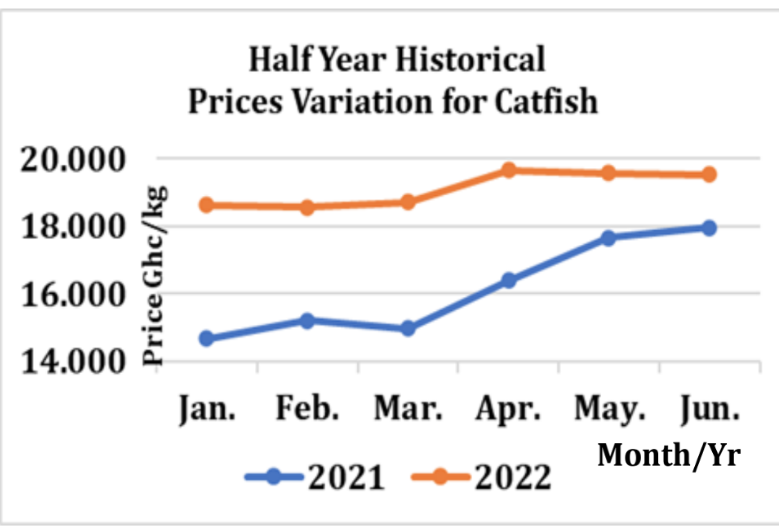
Weekly Prices for Tilapia and Catfish https://www.chamberofaquaculture.com/chamber/2022pdf.html
___
Key Policies and Programmes
Permits for Aquaculture Operations
Aquaculture development in Ghana is governed by the Fisheries Act 625 of 2002 and Fisheries Regulations, 2010. A copy of the Act could be obtained at:-http://extwprlegs1.fao.org/docs/pdf/gha151991.pdf).
The following permits are required for establishing a fish farm: Environmental permit from the Environmental Protection Agency (EPA), water usage rights from the Water Resources Commission (WRC) and production permit from the Fisheries Commission (FC).
Key projects under implementation in the sub-sector include:
- Aquaculture for Food and Jobs
This is a flagship project of the Ministry of Fisheries and Aquaculture Development, aimed at enhancing domestic fish production and creating jobs for the unemployed/ under employed youth along the aquaculture value chain.
2. Technologies for African Agricultural Transformation
The TAAT Aquaculture compact is one of the fifteen compacts comprising the Technologies for African Agricultural Transformation programme (TAAT) led by the WorldFish Centre. The Compact aims at disseminating and upscaling Aquaculture technologies across Africa to increase farmers’ productivity, increase fish protein consumption and enhance sustainability across Aquaculture value chain.
The technologies include: Fast growing quality fish seeds and improved fish rearing technologies: Tilapia (Oreochromis niloticus) and catfish (Clarias gariepinus, hybrids of Hetero-clarias), Quality low-cost fish feed using local raw materials and improved post-harvest technologies and product development.
Specific objectives of the Aquaculture Compact include:
- Creating an enabling environment for aquaculture technology adoption by the value chain actors;
- Facilitate effective delivery of technologies to fish farmers and other actors along the aquaculture value chain;
- Increase aquaculture production and productivity through the identification and dissemination of quality tilapia and catfish seed, production of low-cost fish feed and value addition.
3. Tiseed Project
The Tilapia Seed project titled, “Accelerating aquaculture development in Ghana through sustainable Nile Tilapia seed production and dissemination” has an overall objective to improve productivity and profitability of tilapia cage and pond farming in Ghana.
It is a 3-year project (2019 to 2022), focused on tilapia seed improvement and is being implemented by a consortium of international and local research institutes, led by the International Food Policy Research Institute (IFPRI), supported by the CSIR-Water Research Institute (CSIR-WRI), KIT Royal Tropical Institute in the Netherlands, and WorldFish. Other partners are Fisheries Commission (a government institution) and two private hatcheries (S-HOINT Ltd. and Crystal Lake Ltd.). The project has multiple components including diagnostic study, capacity assessments of actors, household surveys, characterization of fingerling and tilapia genetic make-up and productivity performance via on-farm trials; interventions design via randomized control trials, and impact evaluation.
___
Email: Editor@agricinafrica.com

Comments
Post a Comment